There are a wide array of armor used on Titan. Not all of the listed armor is found everywhere. Many are specific to cultural areas, some are favored by different races or nations. Others are a function of environment and available materials. All are listed here for convenience and comparison. (PHB) = The same as the type listed in the Players Hand Book.
|
ARMOR |
PRICE |
ARMOR CLASS (AC) |
WEIGHT LBS |
Bulk |
|
Arming Doublet |
2gp |
9 |
1 |
Non |
|
Banded mail (PHB) |
100gp |
4 |
35 |
Bulky |
|
Brigandine |
120gp |
6 |
22 |
Slightly |
|
Bronze Plate, full set |
400gp |
3 |
55 |
Bulky |
|
Gambeson^ |
8gp |
7 |
7 |
Slightly |
|
Hide Armor |
35gp |
8 |
25 |
Slightly |
|
Lamellar* metal hauberk (PHB) |
80gp |
4 |
40 |
Bulky |
|
Lamellar* metal byrne |
65gp |
4 |
30 |
Bulky |
|
Light Leather armor |
5gp |
9 |
5 |
Non |
|
Molded (Boiled) Leather armor (PHB) |
10gp |
8 |
15 |
Slightly |
|
Studded leather, hauberk (PHB) |
20gp |
7 |
25 |
Fairly |
|
Studded leather, byrne |
15gp |
7 |
15 |
Fairly |
|
Mail hauberk, butted (PHB) |
75gp |
5 |
35 |
Fairly |
|
Mail byrne, butted (PHB) |
60gp |
5 |
24 |
Fairly |
|
Noble Mail hauberk, riveted |
300gp |
4 |
36 |
Fairly |
|
Noble Mail byne, riveted |
240gp |
4 |
25 |
Fairly |
|
Double Mail hauberk, butted |
225gp |
3 |
50 |
Fairly |
|
Double Mail byrne, butted |
180gp |
3 |
39 |
Fairly |
|
Double Noble Mail hauberk, riveted |
900gp |
2 |
51 |
Fairly |
|
Double Noble Mail byrne, riveted |
720gp |
2 |
40 |
Fairly |
|
Imperial mail, hauberk |
1500gp |
3 |
35 |
Fairly |
|
Imperial mail, byrne |
1200gp |
3 |
24 |
Fairly |
|
Double Imperial mail, hauberk ** |
4500gp |
1 |
50 |
Fairly |
|
Double Imperial mail, byrne ** |
3600gp |
1 |
39 |
Fairly |
|
Back-and-breast plate |
200gp |
3 |
25 |
Bulky |
|
Plate mail (PHB) |
400gp |
3 |
50 |
Bulky |
|
Full Noble plate |
2000gp |
-1 |
60 |
Fairly |
|
Full Imperial plate ** |
6000gp |
-2 |
70 |
Fairly |
|
‘Hoplite’ armor (breast plate only) |
160gp |
3 |
13 |
Fairly |
|
‘Hoplite’ bronze (breast plate only) |
160gp |
3 |
17 |
Fairly |
|
Padded Armor (PHB) |
4gp |
8 |
6 |
Slightly |
|
Ring mail (PHB) |
100gp |
7 |
30 |
Fairly |
|
Scale armor, Light, hauberk length |
60gp |
7 |
30 |
Fairly |
|
Scale armor, Light, byrne length (PHB) |
40gp |
7 |
20 |
Fairly |
|
Scale armor, Heavy, hauberk length (PHB) |
120gp |
6 |
40 |
Fairly |
|
Scale armor, Heavy, byrne length (PHB) |
80gp |
6 |
30 |
Fairly |
|
Wood/bone armor (Lamellar type) |
50gp |
7 |
20 |
Fairly |
* Lamellar replaces Splint
** Dwarven manufacture
^ A Gambeson tailored for a Magic User is more expensive due to the extra pockets and modifications.
Armor Notes
Armor Bulk: See House Rules
Munition Grade: This refers to the plain, unadorned, often ‘mass produced’ armor and weapons used to equip armies and Men at Arms by the ruling class. Quality is decent but unexceptional. It is the grade of armor and weapon reflected in the Price Lists.
Custom: Refers to armor and weapons that are either made to order or, are somewhat ornamented or otherwise enhanced to increase their appeal to ‘Adventurers’ flush Mercenaries and minor Nobles. They are not necessarily of better quality or jewel encrusted, but they will have some extra gilt, trim, engraving, decoration, etc. Example: Brass fittings vs iron. Costs increase 10% to 50% or more for precious metals and jewels.
SPECIAL NOTE: Most armors require (or benefit) from wearing an under layer of padding, multiple layers of cloth or leather. Metal armors, with or without under layers, are very good at stopping/deflecting cutting and impaling attacks, but are poor at preventing damage from crushing damage. The padding helps take up the slack vs crushing damage. Wearing mail, lamellar, splint, plate, studded leather or boiled leather WITHOUT an under layer will cause crushing damage to be increased 50%. Example: A blow from a mace does 6hp damage. The target is not wearing an under layer beneath his mail. He takes 9hp damage from the blow.
Gambeson: Typically a knee length, long sleeve, coat made from layers of sewn linen, with extra padding and leather strips at key points in between. Gambesons generally have a decorative outer layer or ‘finish’ of colors or patterns, and are waxed or oiled cloth for water resistance. (Vs rain not immersion.) They are usually worn alone, though they can be worn under most armor. They can be worn by Magic Users and can also act as a cold weather coat. Many nobles and wealthy individuals use them as as casual or ‘day to day’ protection around their homes or in non threatening environments. They often have leather trim and most have pockets sewn into them and have an attached or detachable hood. The Gambesons favored by Magic Users are more expensive then the basic gambeson due to the extra features commonly added.
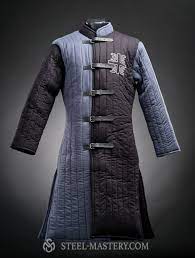
Gambeson
Padded Armor is usually plain and unfinished and is used under other armor or as a home spun armor made for family members serving in local militias. This armor provides some protection in itself but is usually employed as an under layer for some armor types in order to absorb damage that would be transmitted through the armor and to avoid chafing and blisters. Under armor padding usually has straps, buckles and lacing at various points to help secure the armor to the padding. These are not found on the Padded Armor worn by poorer troops. Padded armor also provides some warmth in the cold. Can be worn by Magic Users.
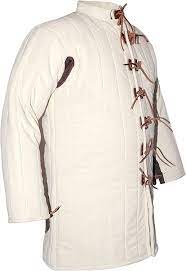
Padded Armor
Arming Doublet: Also called a ‘Jack’ or ‘Jake’ A short waisted, sleeveless, padded ‘vest.’ It is the minimum padding needed under most mail, and torso armor. Full Padded Armor is needed under plate. An Arming Doublet usually has straps, buckles and lacing at various points to help secure the armor to the padding. Arming Doublets also provides some warmth in the cold.
Sometimes worn by Thieves and Magic Users.

Arming Doublet
Light Leather: A thick (¼ to ½ inch) soft and flexible layer of finished leather. Usually Bull Hide or similar. Suitable as an under layer for mail and other armor, it can be very hot and does not absorb sweat like padded armor or an arming doublet. It’s protective quality is similar to padded, but it is not as bulky and can be worn under a variety of clothing, unlike padded. Unlike an Arming Doublet, Light Leather is somewhat water repellent in a rainy environment, but they do not provide any warmth in a cold region. Popular with thieves and Magic Users.
Molded (Boiled) Leather: Thick, (½ to 1 inch) treated leather, tough and rigid that can be shaped and molded and will hold its form. The leather is shaped into a breast plate or cuirass, but much, much lighter then a metal equivalent! While still soft it is is easily impressed with decorative patterns and textures. An arming doublet or multi layers of clothing or padded armor is needed. Helmets are also made from this, as are some scroll cases and boxes and packs. Used by some thieves expecting trouble.
Molded (Boiled) Leather with Mail: A layer of mail, between the Leather and the padding. Butted improves AC by 1, Riveted by 2, Welded by 3. Double mail improves it an additional 2.
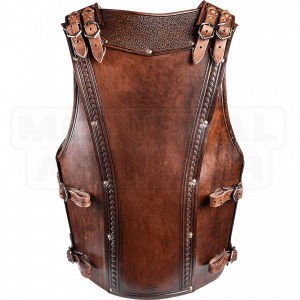
Molded Leather
Studded Leather: A type of lamellar made using leather lamelleas and rivets to connect the pieces together. Length and coverage is like a hauberk or a byrne. An arming doublet, multi layers of clothing or padded armor is needed.
Studded Leather with Mail: A layer of mail, between the leather and the padding. Butted improves AC by 1, Riveted by 2, Welded by 3. Double mail improves it an additional 2.
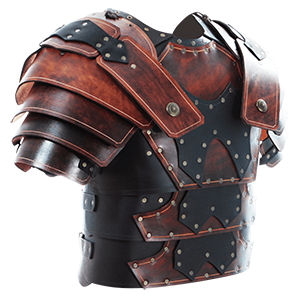
Studded Leather
Hide Armor: Made from layers of skins and hides that are laced together. Mostly used by the poorest of the Upland and Nomadic Gallenic clans or the most isolated Katrallan and Togoth peoples of Palador.
Mail: Also called ‘Chain’ or ‘Chain Mail.’ Consists of inter-locking metal rings or links. Depending on the size of the rings, and the size of the coat, they can number from 10,000 to 50,000+ individual rings. Forging and assembly takes months for a human armorer.
A ‘Hauberk’ is a mail coat that extends from neck to knees. It is usually slit, front and back, for easy movement and riding. Sleeves are full length or half length (to elbows.) This is the ‘chain mail’ armor of the PHB.
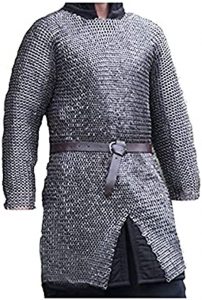
A ‘Byrne’ is a short mail shirt, usually just below the waist or at most mid thigh. It is short sleeved or sleeveless. A Byrne typically weighs a third less then a hauberk and is about 20% less in price.
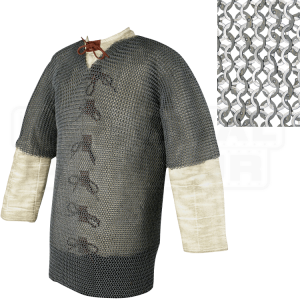
Mail Byrne
A ‘Coif’ is a mail hood that covers head, neck and shoulders. A padded cap is worn underneath. Usually some type of helmet is worn on top.
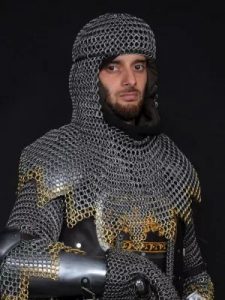
Mail Coif
A ‘Chausse’ is a set of mail ‘trousers’ that pull on and are worn much like chaps.
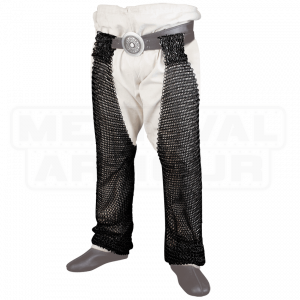
Mail Chausses
Mail comes in three grades or types:
Butted: The ends of each ring are ‘butted’ against each other as they are interlocked with the neighboring rings. This is the most common form of mail and is the mail type available in the standard list. It is the product of all but the finest human armorers and a human sized Hauberk takes an average of 3 to 4 months to make from scratch.. Dwarven Smiths in the great Dwarven Cities, sell ‘sheets’ of butted mail to human armorers and military’s for easier and faster assembly. This can reduce construction of a hauberk to two weeks. This ‘munition grade’ mail that is sold by the Dwarves, is identical in all respects to normal ‘human made’ mail. Butted mail requires regular attention and maintenance from the owner, at least a few hours a week of regular wear and use, otherwise the impact of blows and stress of wear will cause some of the rings to separate and fall off, leaving gaps and unprotected areas. This is the ‘chain mail’ armor of the PHB.

Butted Mail
Riveted: Each of these rings have ends that are flattened and pierced, with tiny rivets connecting the ends and completing the interlocking with the neighboring rings. A an extremely slow and time consuming process that increases production time by 6 months (9 to 10 total) and cost by a factor of 4. Referred to as ‘Noble Mail or Noble Armor’ by the makers it improves AC by 1 (Making a Mail Hauberk AC 4 without a shield.) The Dwarves almost never make riveted mail (see Welded) except on special order. Elven Mail IS riveted (See Below for details.)
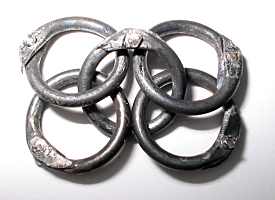
Riveted Mail
Welded: Each of the rings ends are welded together after being inter connected to the neighboring rings. This is the strongest mail, increasing AC by 2 (Making a Mail Hauberk AC 3 without a shield.) The manufacture of Welded Mail is a Dwarven specialty. The few human armorers who have attempted the task have found production times of 18 months or longer and the results unsatisfactory. It is called ‘Imperial mail’ by the Dwarves and the product, when it is available, typically costs 20x butted mail. Dwarven made ‘Imperial Mail’ never rusts and requires virtually no maintenance beyond simple cleaning. It IS NOT Magical, though it can be enchanted.
Double Mail: As the name implies, this is a double layer of mail, linked together, covering the vitals. Torso/Body, front and back. It is impractical for limbs, being too restrictive. It improves AC by 2, in addition to the type of mail used. It adds an additional 15lbs to the weight of a hauberk or byrne and triples the price of the type of mail.
Elven Mail: The mail produced by the Elves is made of an alloy that is one of their secrets. It is NEVER sold and only rarely gifted to non Elves. Elven mail is riveted, but DOES NOT have the AC bonus of regular riveted mail. What makes it ‘Special’ is the extra properties of the armor. Like Dwarven Imperial Mail, it never rusts. It is Non Bulky and weighs less then half of a normal mail shirt of comparable size (Mail Hauberk = 40lbs Elven Mail Hauberk = 15lbs) NOTE: This weight reduction is the reason the riveting does not add to the AC. Whatever the elves do in making it, the armor does not interfere with spell casting! Assuming you can find it for sale, it will cost 100x normal mail.
NOTE: Mail (with padding) is often worn with/under Banded, Lamellar and Plate armors. Doing so improves the ‘better’ armor’s AC by 1. Riveted mail improves it by 2. Welded by 3 and Double mail by an additional 2. This does add, considerably, to weight so only the strongest wear armor layered like this.
Brigandine: This armor is generally a short waisted, sleeveless vest or doublet that has an inner layer of soft padding and an outer layer of soft, or light, leather with the space in between reinforced with a layer of small, light, lamellea plates or scales. Somewhat expensive, it is popular with thieves as it is very quiet since the metal bits are sewn to the padding and covered in leather. Decorative and stylish versions, with outer layers of linrn, silk or similar, are popular with nobles and those with money. To casual examination it can be mistaken for an Arming Doublet. AC= 6
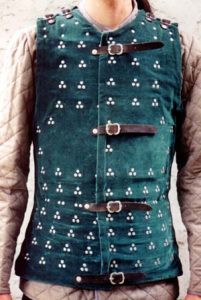
Brigadine
Lamellar Armor: Consisting of small lamellae, or plates that overlap and are linked together with wire, rivets, studs, links etc. Unlike scale armor, there is no backing of leather or cloth. Padded armor or an ‘Arming Doublet’ must be worn under lamellar to prevent chafing, blisters and to help absorb impact. Length and coverage is like a hauberk or a byrne. Lamellas can be made of leather, metal, bone or even pieces of wood. ‘Studded Leather consists of leather lamellae over lapping and connected with studs or rivets. NOTE: Metal Lamellar armor replaces ‘Splint’ which did not exist as a stand alone type of armor.
Lamellar Armor with Mail: A layer of mail, between the lamellar and the padding. Butted improves AC by 1, Riveted by 2, Welded by 3. Double mail improves it an additional 2.
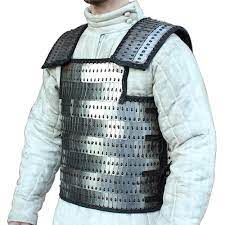
Lamellar
Scale Armor: Consists of over lapping ‘scales’ made of metal, bone, leather or wood. Unlike lamellar armor, the scales are sewn to and/or riveted to, a leather or cloth backing. This backing eliminates the need for padded armor or an arming doublet. Scale armor comes in two weights; ‘Light’ which has either bone or light weight metal scales (AC=7) or Heavy (regular) where the scales are made of better grade metal (AC=6.) Length and coverage, in either case, is like a hauberk or a byrne.
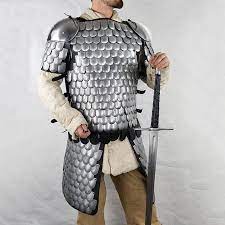
Scale Armor
Banded Armor: A type of armor that is comparable to the Roman, Lorica segmenta armor. Consisting of bands or hoops that wrap around the body, overlapping, and are internally linked together. It requires an Arming Doublet or multiple layers of clothing to pad the wearer.
Banded Armor with Mail: A layer of mail, between the Banded and the padding. Butted improves AC by 1, Riveted by 2, Welded by 3. Double mail improves it an additional 2.
Ring Armor: Flattened metal ‘rings’ like washers, riveted edge to edge to a leather tunic or coat. Used by some Humanoid tribes that are ‘metal poor’ or lacking in technical skills. Found in some human groups with similar lack of resources or skills.
Plate Armor: There are a variety of armors that are referred to as ‘Plate’ and some types are particular to an area or group. Unlike Mail or other armors, ‘Plate’ usually refers to a set of pieces or parts that together protect the wearer.
The common ‘pieces’ of plate armor (in Titan) are: The Breast Plate, the Back Plate, the Vambraces (fore arm guards) and the Greaves (Shin guards.) Additional pieces include Gauntlets usually made of leather and mail. The Faulds a mail ‘skirt’ that protects the area of the groin and upper thighs. And the Chausse (mail) trousers/chaps that protect the lower legs instead of, or in addition to, the greaves and faulds. The mail Coif that covers head and neck, in conjunction with an arming cap or hood and helmet.
The Pteruges are a defensive skirt of leather or multi-layered fabric (linen) strips or lappets worn de-pendant from the waists of cuirasses of warriors and soldiers, defending the hips and thighs, in lieu of faulds. Similar defenses, epaulet like strips, are sometimes worn on the shoulders, protecting the upper arms if the hauberk or byne has short sleeves or is sleeveless.
NOTE: The fully articulated Plate Armor of Late Medieval and Renaissance Europe DOES NOT EXIST on Titan!
Breast Plate: The basic piece of plate armor. It is JUST the front breast plate. The back is leather straps and the AC there is 10 (if an Arming Doublet or padded is worn then 9.) Sometimes referred to as ‘Hoplite Armor.’ AC= 4 (front only)
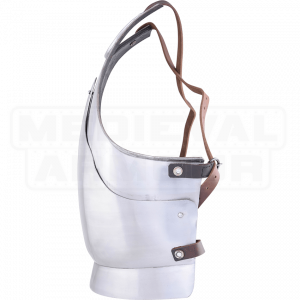
Breast Plate
Cuirass: Commonly called a ‘Clam Shell’ or ‘Back & Breast’ it consists of a front and back plate torso armor. Worn with an arming doublet or padded armor AC= 4.
Cuirass with Mail: A layer of mail, between the plate and the padding. Butted improves AC by 1, Riveted by 2, Welded by 3. Double mail improves it an additional 2.
Bronze Plate: Generally Bronze Plate Armor is either only a Breast Plate or a ‘clam shell’ Cuirass. Bronze armor, though obsolete in most of Solista and Palador, is still found in some town and city armories and in iron poor regions. AC= 4
‘Standard’ Plate Armor: Consists of Back & Breast, a set of Greaves, two Vambraces and Pteruges. It includes an Arming Doublet. (This is the basic Plate in the PHB) AC= 3
Standard Plate Armor with Mail: A layer of mail, between the plate and the padding. Butted improves AC by 1, Riveted by 2, Welded by 3. Double mail improves it an additional 2.
Full ‘Noble’ Plate: Consists of fitted Back & Breast, a mail Coif and Chausse. A knee length, long sleeved Double Mail Hauberk (under the breast & back plate) a set of Greaves and two Vambraces fitted to go over and attach to the hauberk and Chausse. ALL mail is Riveted. Leather and mail Gauntlets, and Great helm are included. It includes full padding. Fitted armor suits are manufactured and designed to assemble smoothly and are fitted for and to the owner. As a result it is less bulky (considered chain mail = Fairly ) then regular plate with mail. Refitting a suit requires a skilled armorer and costs $300. (This is the BEST human made, non magical, suit of armor available in Titan!) AC = -1
Full ‘Imperial’ Plate: Consists of fitted Back & Breast, a mail Coif and Chausse. A knee length, long sleeved Double Mail Hauberk (under the breast & back plate) a set of Greaves and two Vambraces fitted to go over and attach to the hauberk and Chausse. ALL mail is Welded, all plate pieces are Dwarven plate. Leather and mail Gauntlets, and Great helm are included. It includes full padding Fitted armor suits are manufactured and designed to assemble smoothly and is fitted for and to the owner. As a result it is less bulky (considered chain mail = Fairly) then regular plate with mail. Refitting a suit requires a Dwarven armorer and costs $600. (This is the BEST non magical suit of armor available in Titan!) AC = -2
Dwarven Plate: Dwarven smiths manufacture and sell, at premium prices, (4x regular price) plate armor suits and pieces. Dwarven plate never rusts, requiring minimal care, and their metallurgy and techniques result in plate armor that is a third lighter then corresponding human made armor. There is no difference in AC between human and Dwarven plate armor. NOTE: This is NOT enchanted though it can be enchanted.
Armor Sizing and Fitting
Most metal armor is manufactured by and for Humans or Dwarves. Some other races make some armor, but they are made for their own people and do not enter into consideration here.
Whether made by Humans or Dwarves, most armor is produced for use by humans and most of the sizing is Human Averages. Other size ranges are Dwarves, with smaller Dwarven sizes suitable for most Halflings. Elves and Half Elves can usually wear smaller human sized armors, though Elves manufacture their own for their people.
‘Off the Rack’ armor has a fair bit of adjustment using straps and buckles and fill excess space with padding as needed. There is enough play in the armor that gender is rarely an issue in wearing such armor. (The Breast Plates of Plate and Molded Leather armors are the exception.
True ‘Custom Fitted’ armor is expensive, adding 100gp to the price of leather based armors (including Brigadines and Scale) and 200gp to all others. The fitting and alterations take 2 weeks for leather and fabric and a month for metal. Refitting a Custom piece is even more expensive (material has often been removed and must be replaced) and usually cost 50% to 100% more. Dwarven Armorers are required to fit Dwarven made armor and they charge more! The benefit of Custom Fitting is that it reduces the Bulkiness of the armor by 1 level. Plate goes from Bulky to Fairly. Mail from Fairly to Slightly. Brigandine from Slightly to Non. With the exception of Brigandine and Elfin Mail, no metal armor can be reduced past Slightly in bulk.
Bulk and what it means
The Bulk of an object is different then the Weight of an object. Weight, and how much your character can carry before being slowed down is addressed by the character’s strength. But Bulkiness impacts an individuals ability to move about, squeeze through spaces, bend and stretch and so on. Specifically it impacts the character’s Dexterity.
Generally speaking, the things that most impacts a player character’s ‘bulkiness’ are armor, shields and back packs, Of the three, armor is the most important. (A character can easily drop a shield or pack as needed, armor is harder to set aside.)
Armor is specifically designed for Defense and as such will NOT impact a character’s Defensive Adjustment in a negative way. However, it WILL impact the character’s Reaction Adjustment. Specifically in the character’s Reaction Roll for Initiative. Note: It DOES NOT impact Surprise rolls! Just because the heavily armored fighter may be slower getting to his feet or unlimbering shields and weapons, it does not mean that he or she was less attentive or aware and more easily surprised. Nor, does it mean that once a missile weapon is in hand, the armored fighter is impaired in ability to use it. It strictly impacts the Initiative Roll in determining who gets to act when in the combat round.
Some armors, especially those that need padding underneath them, are very Bulky. Some of this type can benefit from custom fittings and high levels of craftsmanship to reduce their bulkiness to some degree. These, along with many armors made of multiple material layers, are Fairly bulky. Some armor types are, by nature, stiff and unyielding. For example, Molded or ‘Boiled’ Leather or a Gambeson. These are Slightly bulky. And some armors do not inhibit at all. These are Non bulky. An armor types Bulk can be found on the chart alon with weight, price and AC.
|
Degree of Bulkiness |
Impact on Initiative Rolls |
|
Bulky |
+3 to Reaction Adjustment |
|
Fairly |
+2 to Reaction Adjustment |
|
Slightly |
+1 to Reaction Adjustment |
|
Non |
No effect. Normal Reaction Adjustment |
Note: A + to reaction adjustment means that the penalty is ADDED to a character’s initiative roll. Lengthening the time the character takes to react to a crisis situation.
Magic Armor: The enchantment effect of magic armor reduces the armor type’s Bulkiness by 1 level. Bulky to Fairly. Fairly to Slightly. Slightly to Non. Non cannot be reduced further. The enchantment also reduces armor weight slightly, typically 20% unless specified otherwise.